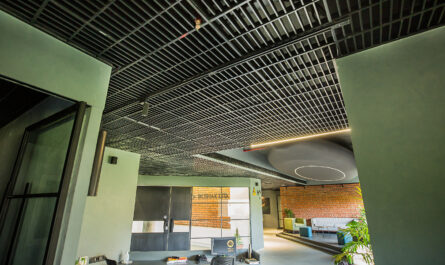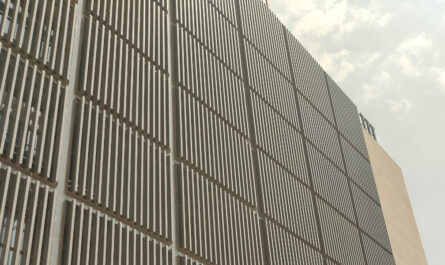Vertical architectural louvers represent one of the most versatile and visually striking building elements available to modern architects and designers. More than just aesthetic additions, these precision-engineered components deliver significant performance benefits including solar shading, improved energy efficiency, and enhanced privacy while maintaining views and ventilation. This comprehensive guide explores how vertical louvers can transform both the functionality and appearance of your next architectural project.
What Are Vertical Architectural Louvers?
Definition and Core Functions
Vertical architectural louvers are precisely angled slats or blades installed perpendicular to the ground on building exteriors. Unlike horizontal louvers that stack vertically, these systems run from top to bottom with adjustable or fixed blades that can be positioned to control:
- Solar heat gain
- Natural light penetration
- Views to and from the building
- Air circulation patterns
- Privacy levels
Materials and Construction
At Metalium, our vertical louvers are manufactured using:
- Aluminum – Lightweight, corrosion-resistant, and ideal for most applications
- Steel – For increased strength requirements
- Composite materials – Offering unique aesthetic and performance properties
- Wood and wood-look finishes – For projects requiring warmth and natural aesthetics
Performance Benefits of Vertical Architectural Louvers
Superior Solar Control
Vertical louvers excel at blocking low-angle sunlight, particularly effective for east and west-facing facades where traditional horizontal solutions struggle to prevent glare and heat gain.
- Seasonal Adaptation: Fixed vertical louvers can be precisely angled to block summer sun while allowing beneficial winter solar gain
- Dynamic Control: Motorized systems adjust throughout the day, optimizing light and heat management
- Energy Impact: Properly designed vertical louvers can reduce cooling loads by 25-40%
Enhanced Natural Daylighting
One of the most significant advantages of vertical louver systems is their ability to redirect natural light deep into interior spaces.
- Light Redirection: Specialized blade profiles scatter diffused light toward ceilings
- Glare Reduction: Strategic placement prevents harsh direct light while maintaining brightness
- Reduced Artificial Lighting: Studies show up to 35% reduction in daytime lighting energy use
Weather Protection
Vertical louvers provide excellent defense against wind-driven rain and snow while still allowing ventilation.
- Wind Resistance: Vertical orientation naturally sheds wind forces
- Rain Screening: Directs water away from building openings
- Snow Management: Prevents accumulation better than horizontal systems
Acoustic Performance
Often overlooked, vertical louvers can significantly improve acoustical performance:
- Sound Diffusion: Breaks up sound waves to reduce echo and reverberation
- Traffic Noise Reduction: Properly designed systems can achieve 4-8 dB reduction
- Combined Systems: Integration with acoustic materials for enhanced performance
Design Applications and Aesthetic Benefits
Architectural Expression
Vertical louvers offer architects unprecedented design flexibility:
- Visual Interest: Create dynamic shadow patterns that change throughout the day
- Building Articulation: Break up large facades into more human-scaled elements
- Texture and Depth: Add dimension to otherwise flat surfaces
Integration with Building Systems
Modern vertical louver systems seamlessly integrate with:
- Building Management Systems: Automated control based on environmental conditions
- HVAC Optimization: Coordination with mechanical systems for peak efficiency
- Lighting Controls: Synchronization with artificial lighting for optimal energy use
Design Versatility
Metalium’s vertical louvers offer unlimited design possibilities:
- Custom Blade Profiles: Standard, airfoil, rectangular, tubular, or custom designs
- Variable Spacing and Projection: Create unique patterns and depth
- Color and Finish Options: Endless aesthetic possibilities from anodized finishes to custom powder coats
Installation Considerations
Structural Integration
Proper mounting ensures optimal performance and longevity:
- Support Systems: Options include outriggers, continuous angles, or direct attachment
- Wind Load Calculations: Critical for safety and performance
- Expansion Considerations: Accommodating thermal movement
Maintenance Requirements
Metalium’s vertical louver systems are designed for minimal maintenance:
- Self-Cleaning Angles: Promotes water and dirt shedding
- Accessible Components: Simplifies inspection and maintenance
- Durable Finishes: Resistant to fading, corrosion, and wear
Selecting the Right Vertical Louver System
Project Assessment Factors
When considering vertical louvers, evaluate:
- Solar Orientation: East/west facades benefit most from vertical orientation
- Climate Considerations: Different requirements for hot/humid vs. cold/dry regions
- Visual Objectives: Privacy needs, view preservation, and aesthetic goals
- Performance Priorities: Energy savings, daylighting, or weather protection
Customization Options
Metalium offers extensive customization options:
- Blade Size and Spacing: From subtle screening to bold architectural statements
- Mounting Systems: Flexible solutions for any building type
- Control Mechanisms: Manual, motorized, or automated systems
- Integrated Technology: Solar cells, lighting, or sensors
Future Trends in Vertical Louver Systems
Smart Building Integration
- AI-Driven Optimization: Systems that learn and adapt to usage patterns
- Occupant-Controlled Apps: Allowing individual adjustment in multi-tenant buildings
- Predictive Positioning: Weather forecast integration for proactive adjustment
Sustainable Innovations
- Biophilic Integration: Combining louvers with vertical gardening systems
- Zero-Carbon Manufacturing: Reducing embodied energy in louver systems
- End-of-Life Planning: Recyclable and reusable component design
Conclusion
Vertical architectural louvers represent an optimal balance of form and function, delivering measurable performance benefits while creating visually striking facades. As buildings face increasing demands for energy efficiency and occupant comfort, these adaptive systems offer solutions that work with nature rather than against it.
At Metalium, we’re committed to pushing the boundaries of what’s possible with vertical louver design, engineering, and installation. Our dedicated team works closely with architects and builders to create custom solutions that exceed performance expectations while achieving bold design visions.
FAQ
What makes vertical louvers different from horizontal louvers?
Vertical louvers run perpendicular to the ground and are particularly effective at blocking low-angle sun from east and west exposures, while horizontal louvers excel at blocking high-angle sun typically from southern exposures (in the northern hemisphere).
Can vertical louvers be retrofitted to existing buildings?
Yes, Metalium offers retrofit solutions that can be installed with minimal disruption to the building envelope or occupants. These systems can dramatically improve energy performance in older buildings.
What maintenance do vertical louvers require?
Most systems require only periodic inspection and cleaning. Motorized systems may need occasional lubrication and control system updates. Metalium’s systems are designed for minimal maintenance.
How long do vertical louver systems typically last?
With proper specification and installation, quality vertical louvers can last 30+ years. Metalium’s systems are engineered for durability with high-performance finishes and corrosion-resistant materials.
Can vertical louvers be used for interior applications?
Absolutely. Interior vertical louvers are excellent for space division, light control between zones, and creating visual interest while maintaining openness and air circulation.
Are there any tax incentives for installing vertical louvers?
Many regions offer energy efficiency incentives that may apply to buildings with vertical louver installations. These can include tax deductions, utility rebates, or incentive payments based on demonstrated energy savings.




